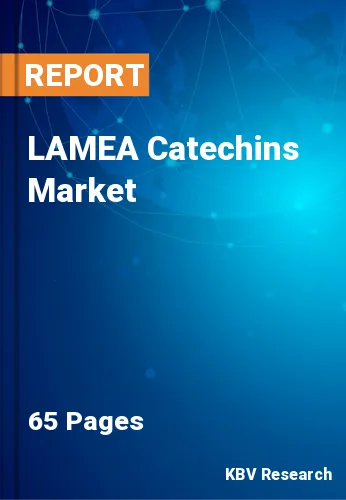The Latin America, Middle East and Africa Catechins Market would witness market growth of 7.7% CAGR during the forecast period (2022-2028).
Catechins decrease the amylase enzyme's activity in the human small intestine, and some of them are absorbed into the portal vein. Whereas catechins are recognized to have bactericidal capabilities, lactic acid bacteria are unaffected by them. Various research has shown that consuming tea catechins for several weeks can reduce the number of putrefactive substances in the body and increase the presence of organic acids by lowering the intestinal pH.
Animal models for common malignancies at various organ sites have been used to illustrate the possible anti-cancer capabilities of tea (such as green tea), and more recent, in-depth epidemiological studies have also raised the possibility. One of the food materials that has likely received the most in-depth research on its health benefits is tea catechins, namely their main component, EGCG.
The anti-obesity property of tea catechins has been the focus of several animals, cell, and human investigations over the past few years, which have gradually revealed their positive benefits and action mechanisms. A solid foundation for the assumption that long-term utilization of tea catechins (in an appropriate amount) may have positive effects in the prevention and treatment of obesity has been established, despite the need for larger-scale human studies to confirm catechin efficacy, including their cumulative effects with exercise.
In recent years, overweight and obesity rates have increased throughout Central and South America, which has increased health awareness and changed consumer preferences toward nutritional supplements and organic food items within the LAMEA region. The need for catechin in the area is anticipated to rise along with the demand for nutraceutical products. It is also estimated that major manufacturers would spend a lot of money on R&D to create specific dietary supplements. The market in the area is anticipated to benefit from this.
The Brazil market dominated the LAMEA Catechins Market by Country in 2021, and would continue to be a dominant market till 2028; thereby, achieving a market value of $311.5 Thousands by 2028. The Argentina market is experiencing a CAGR of 8.3% during (2022 - 2028). Additionally, The UAE market would display a CAGR of 7.5% during (2022 - 2028).
Based on Source, the market is segmented into Tea, Fruits, and Others. Based on Type, the market is segmented into Epigallocatechin-3- Gallate (EGCG), Epigallocatechin (EGC), and Others. Based on Application, the market is segmented into Pharmaceuticals, Dietary Supplements, Food & Beverages, and Others. Based on countries, the market is segmented into Brazil, Argentina, UAE, Saudi Arabia, South Africa, Nigeria, and Rest of LAMEA.
Free Valuable Insights: The Global Catechins Market is Predict to reach $18.1 Million by 2028, at a CAGR of 4.7%
The market research report covers the analysis of key stake holders of the market. Key companies profiled in the report include INDOFINE Chemical Company, Inc., Indena S.p.A., Cayman Chemical Company, Inc., Chengdu Chelation Biology Technology Co., Ltd., Arjuna Natural Pvt. Ltd., Taiyo International (Taiyo Kagaku Corporation), Infré SA, Carbosynth Ltd., and Botaniex, Inc.
By Source
By Type
By Application
By Country
Our team of dedicated experts can provide you with attractive expansion opportunities for your business.

